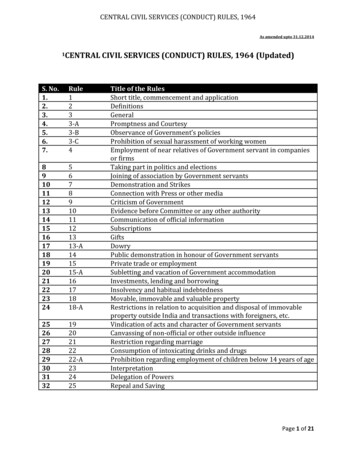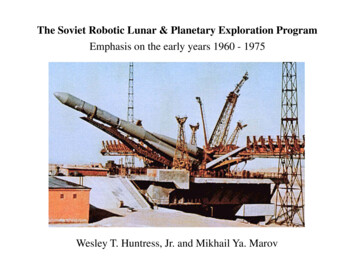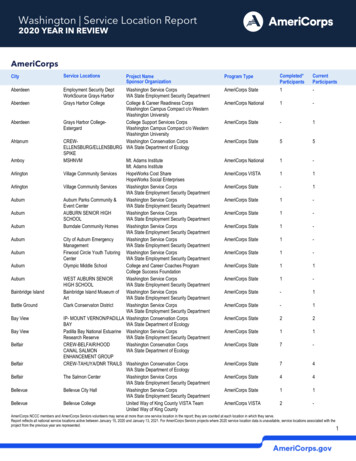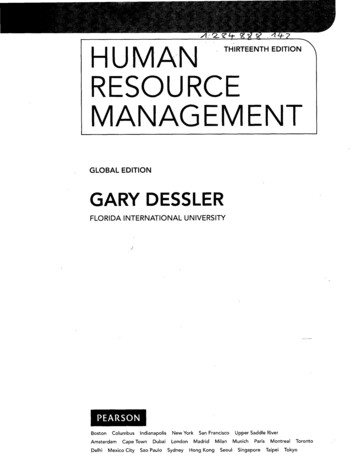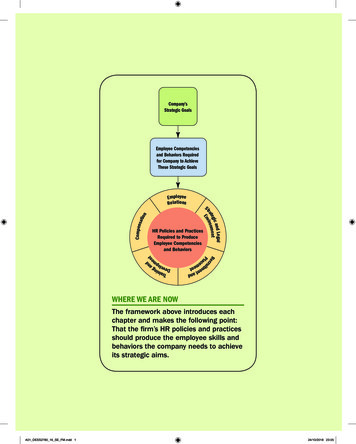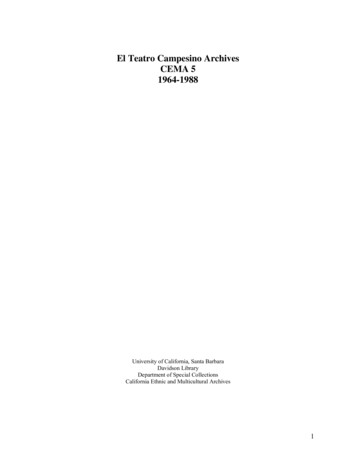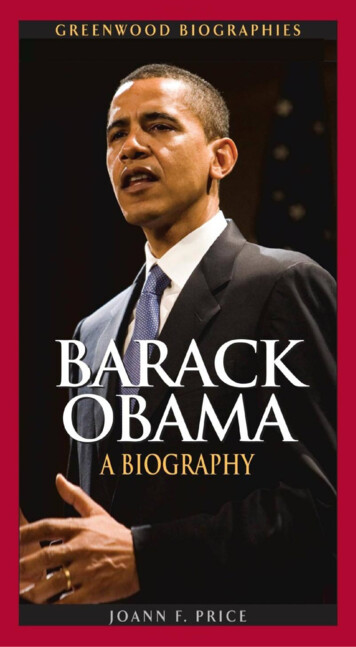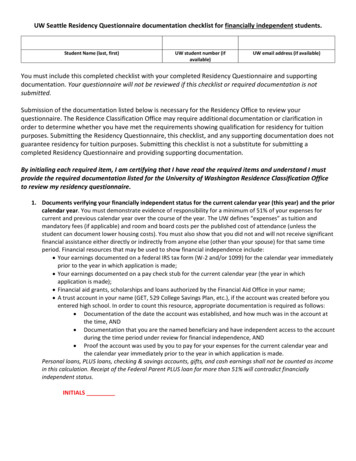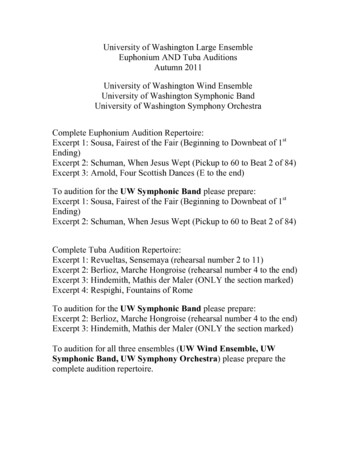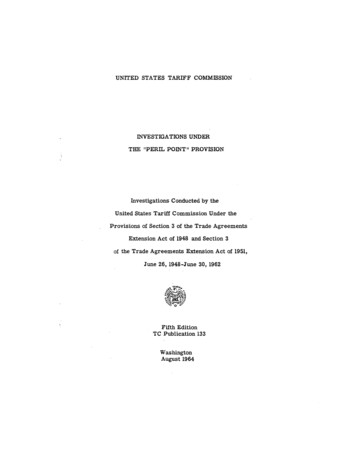
Transcription
UNITED STATES TARIFF COMMISSIONINVESTIGATIONS UNDERTHE "PERM POINT" PROVISIONInvestigations Conducted by theUnited States Tariff Commission Under theProvisions of Section 3 of the Trade AgreementsExtension Act of 1948 and Section 3of the Trade Agreements Extension Act of 1951,Stine 26, 1948-June 30, 1962Fifth EditionTC Publication 133WashingtonAugust 1964
UNITED STATES TARIFF COMMISSIONBen Dorfman, ChairmanJoseph E. TalbotGlenn W. SuttonJames W. CullitonDan H. Fenn, jr.Donn N. Bent, SecretaryAddress all communications toUnited States Tariff CommissionWashington, D.C. 20436
INTRODUCTIONThe following compilation summarizes information on the "perilpoint" investigations that the U.S. Tariff Commission conducted underthe provisions of section 3 of the Trade Agreements Extension Act of1948 1/ and section3of the Trade Agreements Extension Act of 1951. 2/The Commission's principal obligation under those sections terminatedat the close of June 30, 1962, with the termination of the President'sauthority to negotiate tariff concessions on newly listed articles.This compilation of "peril point" actions, therefore, is the last tobe published by the Commission. The Trade Expansion Act of 1962,approved October 11, 1962, requires the Tariff Commission, in lieu'of fixing "peril points," to determine the probable economic effectof modifications of duties or other import restrictions on domesticindustries. The Commission may, therefore, from time to time publishsummaries of its actions conducted under that provision of law.Sections 3 and4of the Trade Agreements Extension Act of 1951set forth the statutory requirements regarding "peril point" determinations in connection with proposed trade-agreement negotiations.The peril-point provisions of the 1951 act, which were substantiallythe same as those that were incorporated in the Trade AgreementsExtension Act of 1948, 3/ required the President, before entering intoany trade-agreement negotiation, to transmit to the Tariff Commissiona list of the commodities being considered for possible concessions.1 62 Stat. 1053.2/ 65 Stat. 72.3/ The Trade Agreements Extension Act of 1949 did not contain theperil-point provision.1
2The Commission was then required to make an investigation (includinga public hearing) and to report its findings to the President on(1) the maximum decrease in duty, if any, that could be made on eachlisted commodity without causing or threatening serious injury to thedomestic industry producing like or directly competitive products, or(2) the minimum . inc.ease in the duty or additional import restrictionsthat might be necessary on'any of the listed products in order toavoid causing or threatening serious injury to such domestic industry.The President was not to conclude a trade agreement until theCommission had made its report to him, or until 6 months fr the datehe transmitted the list of products to the Commission. If the President concluded a trade agreement that provided for greater reductionsin duty than the Commission specified in its report, or that failed toprovide for the additional import restrictions specified, he wasrequired to transmit to the Congress a copy of the trade agreement inquestion, identifying the articles concerned and stating his reasonfor not carrying out the Tariff CommissionTs recommendation. Promptlythereafter, the Tariff Commission was to deposit with the Senate Committee on Finance and the House Committee on Ways and Means a copy ofthe portions of its report to the President dealing with the articleswith respect to which the President had not followed the Tariff Commissionis recommendations.If in the course of any peril-point investigation the Commissionfound--with respect to any article on the President's list upon whicha tariff concession had been granted--that an increase in duty or
3additional import restriction was required to avoid serious injury tothe domestic industry producing like or directly competitive articles,the Commission was required to institute promptly an escape-clauseinvestigation of that article.To give some indication of the scope of the various peril-pointinvestigations that the Commission has conducted, the following compilation shows, for each investigation, the number of tariff paragraphsor subparagraphs that were involved in the President's list. Some ofthe paragraphs or subparagraphs listed related to a single commodity;many related to more than one commodity; and others were "basket"provisions, each of Which covered a large variety of commodities.For this reason, there is also shown for each investigation theapproximate number of statistical (Schedule A) 1/ classifications,or parts thereof, that were involved in the President's list.1/ U.S. Department of Commerce, Schedule A, Statistical Classification of Commodities imported Into the United States.
4Investigations conducted by the U.S. Tariff Commission under the provisions of sec. 3 of the Trade Agreements 1Xtension Act of 1948 andsec. 3 of the Trade Agreements Extension Act of 1951, June 26, 1948June 30, 1962Country 1/Denmark, DoripicanRepublic, El Salvador,Finland, Greece, Haiti,Italy, Nicaragua, Peru,Sweden, and Uruguay(1949).StatusOrigin of investigation: Letter and listof commodities from the President, datedNov. 5, 1948.Scope of investigation: Commoditiesspecified in the President's list ofNov. 5, 1948. The list involved 166tariff paragraphs or subparagraphs,each of which included one or morecommodities, and covered approximately500 statistical (Schedule A) classifications or parts thereof. The commodities were those listed by theInterdepartmental Committee on TradeAgreements in its public notice--issuedNov. 5, 1948--of intention to undertaketariff negotiations with the listedcountries under the General Agreement onTariffs and Trade at Annecy, France.Investigation instituted: Nov. 5, 1948.Hearing held: Dec. 7-14, 1948.Report submitted to the President: Ear. 4,1949.Remarks: Before the Annecy agreement wasconcluded, the "peril point" provisionhad been eliminated from the tradeagreements legislation by the TradeAgreements Extension Act of 1949.lj The year shown in parentheses is the year that the Commission completed, or was due to complete, the particular investigation.
5CountryColombia, Denmark,Dominican Republic,Finland, Greece, Haiti,Italy, Liberia, Peru,Sweden,-and Uruguay(supplemental investigation) (1949).StatusOrigin of investigation: Letter and listof commodities from the President, datedDec. 17, 1948.Scone of investigation: Commoditiesspecified in the President's list ofDec. 17, 1948. The list involved 59tariff paragraphs or subparagraphs, eachof which included one or more commodities,and covered approximately 100 statistical(Schedule A) classifications or partsthereof. The commodities were thoselisted by the Interdepartmental Committeeon Trade Agreements in its supplementarypublic notice--issued Dec. 17, 1948-concerning trade-agreement negotiationswith the listed countries under the General Agreement on Tariffs and Trade atAnnecy, France.Investigation instituted: Dec. 17, 1948.Hearing held: Jan. 25-27, 1949.Report submitted to the President:Apr. 14, 1949.Remarks: Before the Annecy agreement wasconcluded, the "peril point" provisionhad been eliminated from the tradeagreements legislation by the TradeAgreements Extension Act of 1949.
6CountryVenezuela (1951)StatusOrigin of investigation: Letter and listof commodities from the President, datedAug. 29, 1951.Scope of investigation: Commodities specified in the President's list of Aug. 29,1951. The list involved 4 tariff paragraphs and one section of the InternalRevenUe Code, each of which included oneor more commodities, and coveredapproximately 30 statistical (ScheduleA) classifications or parts thereof. .The commodities were those listed by theInterdepartmental Committee on Trade Agreements in its public notice--issued Aug.29, 1951—of intention to negotiate withVenezuela to supplement and amend the1939 bilateral trade agreement with thatcountry.Investigation instituted: Aug 29, 1951.Hearing held: Oct. 2-4, 1951.Report submitted to the President:Dec. 27, 1951.Remarks: The supplementary bilateraltrade agreement with Venezuela wassigned on Aug. 28, 1952; it becameeffective on Oct. 11, 1952. On Aug. 29,1952, the President transmitted to theCongress a copy of the trade agreement,together with a report of the reasonswhy the concession granted with respectto the import tax on crude petroleum,topped crude petroleum, and fuel oilderived from petroleum (including fueloil known as gas oil) did not conformto the limit specified in the Commission'sreport to the President with respect tosuch products. On Sept. 2, 1952, asrequired by law, the Commission transmitted to the Senate Committee on Financeand the House Committee on Ways and Meansa copy of the portions of its report tothe President dealing with the articlesidentified by the President in his reportto the Congress. On Sept. 4, 1952, theCommission made available to the publicthe material it had transmitted to thetwo committees.
7CountryStatusJapan and othercountries (1955).Origin of investigation: Letter and listof commodities from the President s datedNov. 13, 1954.Scooe of investigation: Commoditiesspecified in the President's list ofNov. 13, 1954. The list involved 168tariff paragraphs or subparagraphs, eachof which included one or more commodities, and covered approximately 600statistical (Schedule A) classificationsor parts thereof. The commodities werethose listed by the InterdepartmentalCommittee on Trade Agreements in itspublic notice--issued Nov. 13, 1954--ofintention to undertake tariff negotiations with Japan and other countriesunder the General Agreement on Tariffsand Trade at Geneva, Switzerland.Investigation instituted: Nov. 13, 1954.Hearing held: Dec. 13-23, 1954.Report submitted to the President:Feb. 17, 1955.Japan and other countries(supplemental investigation) (1955).Origin of investigation: Letter and listof commodities from the President, datedFeb. 21, 1955.Scope of investigation: Commoditiesspecified in the President's list ofFeb. 21, 1955. The list involved 28tariff paragraphs or subparagraphs, eachof which included one or more commodities, and covered approximately50 statistical (Schedule A) classifications or parts thereof. Thecommodities were those listed by theInterdepartmental Committee on TradeAgreements in its supplementary publicnotice--issued Feb. 21, 1955--concerningtrade-agreement negotiations involvingJapan and other countries under theGeneral Agreement on Tariffs and Tradeat Geneva, Switzerland.Investigation instituted: Feb. 21, 1955.Hearing held: Mar. 28-Apr. 1,1955.Report submitted to the President:Apr. 8, 1955.
8CountrySwitzerland (1955)StatusOrigin of investigation: Letter and listof commodities from the President, datedFeb. 21, 1955.Scone of investigation: Commoditiesspecified in the President's list .ofFeb. 21, 1955. The list involved 11tariff paragraphs or subparagraphs,each of which included one or morecommodities, and covered approximately70 statistical (Schedule A) classifications or parts thereof. Thecommodities were those listed by theInterdepartmental Committee on TradeAgreements in its public notice--issuedFeb. 21, 1955--of intention to undertake tariff negotiations withSwitzerland at Geneva, Switzerland, tocompensate Switzerland for the increasein U.S. duty rates on certain watchesand watch movements.Investigation instituted: Feb. 21, 1955.Hearing held: Mar. 28-Apr. 1, 1955.Report submitted to the President:Apr. 13, 1955.
9CountryAustralia, Austria,Belgium, Canada, Chile,Cuba, Denmark, DominicanRepublic, Finland,France, Germany (FederalRepublic), Greece, Haiti,India, Italy, Japan,Luxembourg, Netherlands,Nicaragua, Norway, Peru,Sweden, Turkey, Unionof South Africa, andUnited Kingdom (1956).StatusOrigin of investigation: Letter and listof commodities from the President, datedSept. 21, 1955.Scope of investigation: Commoditiesspecified in the President's list ofSept. 21, 1955. The list involved 350tariff paragraphs or subparagraphs and1 section of the Internal Revenue Code,each of which included one or morecommodities, and covered approximately1,250 statistical (Schedule A) classifications or parts thereof. Thecommodities were those listed by theInterdepartmental Committee on TradeAgreements in its public notice--issuedSept. 21, 1955--of intention to undertake tariff negotiations with the listedcountries under the General Agreement onTariffs and Trade at Geneva, Switzerland.Investigation instituted: Sept. 21, 1955.Hearing held: Oct 31-Nov. 10, 1955.Report submitted to the President:Jan. 16, 1956.Remarks: The results of the negotiations mentioned above were set forthin a trade agreement which was signedat Geneva on May 23, 1956, by the UnitedStates and 21 other contracting partiesto the General Agreement. The firststage of the United States concessionsbecame effective on June 30, 1956. OnJune 7, 1956, the President transmittedto the Congress a copy of the tradeagreement, together with a report of thereasons why—with respect to the following articles--the minimum requirementsspecified in the Commission's perilpoint report were not complied with inthe trade agreement: Paragraph 302 (h)-Ferrochromium tungsten, chromiUmtungsten, chromium cobalt tungsten,tungsten nickel, and all other alloysof tungsten, n.s.p.f. (not includingferrotungsten); and paragraph 1541 (b)-Violins and violas, of all sizes,wholly or partly manufactured or
10CountryAustralia, Austria,Belgium, Canada, Chile,Cuba, Denmark, DominicanRepublic, Finland,France, Germany.(Federal Republic),Greece, Haiti, India,Italy, Japan, Luxembourg,Netherlands, Nicaragua,Norway, Peru, Sweden,Turkey, Union of SouthAfrica, and UnitedKingdom (1956)—com,Australia, Austria,Belgium, Canada, Chile,Cuba, Denmark,Dominican Republic,Finland, France,Germany (FederalRepublic), Greece,Haiti, India, Italy,Japan, Luxembourg,Netherlands, Nicaragua,Norway, Peru, Sweden,Turkey, Union of SouthAfrica, and UnitedKingdom (supplementalinvestigation) (1956).Statusassembled, made after the year 1800.On June 7, 1956, as required by law.the Commission transmitted to the SenateCommittee on Finance and the House Committee on Ways and Means a copy of theportions of its report to the Presidentdealing with the articles identified bythe President in his report to theCongress. Subsequently, the Commissionmade available to the public the materialit had transmitted to the two committees.Origin of investigation: Letter and listof commodities from the President, datedDec. 9, 1955.Scope of investigation: Commoditiesspecified in the President's list ofDec. 9, 1955. The list involved 32tariff paragraphs or subparagraphs, eachof which included one or more commodities,and covered approximately 50 statistical(Schedule A) classifications or partsthereof. The commodities were thoselisted by the Interdepartmental Committeeon Trade Agreements in its supplementarypublic notice--issued Dec. 9, 1955-concerning trade-agreement negotiationswith the listed countries under theGeneral Agreement on Tariffs and Tradeto be held at Geneva, Switzerland.Investigation instituted: Dec. 9, 1955.Hearing held: Jan. 17-19, 1956.Report submitted to the President:Feb. 10, 1956.
CountryCuba (1956)StatusOrigin of investigation: Letter and listof commodities from the President, datedOct: 8, 1956.Scope of investigation: Commoditiesspecified in the President's list ofOct. 8, 1956. The list involved 2tariff paragraphs, each of whichincluded one or more commodities,and covered 5 statistical (Schedule A)classifications. The commodities werethose listed by the InterdepartmentalCommittee on Trade Agreements in itspublic notice--issued Oct. 8, 1956--ofintention to undertake tariffnegotiations with Cuba under the GeneralAgreement on Tariffs and Trade.Investigation instituted: Oct. 8, 1956.Hearing held: Nov. 14-15, 1956.Report submitted to the President:Dec. 7, 1956.United Kingdom andBelgium (1957).Origin of investigation: Letter and listof commodities from the President,dated Ear. 18, 1957.Scope of investigation: Commodities specified in the President's list of Mar. 18,1957. The list involved 11 tariffparagraphs, each of which included one ormore commodities, and covered 14 statistical (Schedule A) classifications.The commodities were those listed by theInterdepartmental Committee on TradeAgreements in its public notice--issuedMar. 18, 1957--of intention to undertake tariff negotiations with the UnitedKingdom and Belgium under the GeneralAgreement on Tariffs and Trade.Investigation instituted: Mar. 18, 1957.Hearing held: Apr. 24, 1957.Report submitted to the President:May 2 , 1957.
12CountryStatusUnited Kingdom and FederalRepublic of Germany;Sweden, Denmark, Belgium,and the Netherlands; andJapan (1959).Origin of investigation: Letter and listof commodities from the President, datedAug. 19, 1959.Scope of investigation: Commodities specified in the President's list of Aug. 19,1959. The list involved 26 tariff paragraphs, each of which included 1 or morecommodities, and covered 36 statistical(Schedule A) classifications. The commodities were those listed by the Interdepartmental Committee on Trade Agreements in its public notice - -issuedAug. 19, 1959 - -of intention to undertaketariff negotiations, in connection withrequests for compensatory concessions,with the listed countries under theGeneral Agreement on Tariffs and Trade.Investigation instituted: Aug. 19, 1959.Hearing held: Oct. 6-8, 1959.Report submitted to the President:Nov. 23, 1959.United Kingdom andBelgium (1960).Origin of investigation: Letter and listof commodities from the President, datedOct. 22, 1959.Scope of investigation: Commodities specified in the President's list of Oct. 22,1959. The list involved 2 tariff paragraphs, and covered 31 statistical(Schedule A) classifications. The commodities were those listed by the Interdepartmental Committee on Trade Agreements in its public notice - -issuedOct. 22, 1959 - -of intention to enterinto limited trade-agreement negotiationswith the listed countries, under theGeneral Agreement on Tariffs and Trade,for the purpose of modifying U.S. tariffconcessions on certain wool fabrics.Investigation instituted: Oct. 22, 1959.Hearing held: Dec. 1-4 and 7-10, 1959.Report submitted to the President:Feb. 10, 1960.
13CountryEuropean Economic Community(on behalf of Belgium,France, West Germany,Italy, Luxembourg, andthe Netherlands); 17other contracting partiesto GATT (Australia,Austria, Canada, Chile,Denmark, DominicanRepublic, Finland, Haiti,India, Japan, New Zealand,Nicaragua, Norway, Peru,Sweden, the UnitedKingdom, and Uruguay);and 4 countries that haveacceded to GATT provisionally (Israel, Spain,Switzerland, and Tunisia)(1960).StatusOrigin of investigation: Letter and listof commodities from the President, datedMay 13 (received May 27), 1960.Scone of investigation: Commoditiesspecified in the President's list ofMay 13, 1960. The list involved 450tariff paragraphs or subparagraphs, eachof which included one or more commodities,and covered approximately 2,200 statistical(Schedule A) classifications. Thecommodities were those listed by theInterdepartmental Committee on TradeAgreements in its public notice--issuedMay 27, 1960--of intention to participatein multilateral tariff negotiations withthe listed countries within the frameworkof the General Agreement on Tariffs andTrade at Geneva, Switzerland.Investigation instituted: May 27, 1960.Hearing held: July 11-Sept. 7, and Sept. 19,1960.Report submitted to the President: Nov. 25,. 1960.
114Country or commodityStatusEuropean Economic Community(on behalf of Belgium,France, West Germany,Italy, Luxembourg, andthe Netherlands); 17other contracting partiesto GATT (Australia,Austria, Canada, Chile,Denmark, DominicanRepublic, Finland, Haiti,India, Japan, New Zealand,Nicaragua, Norway, Peru,Sweden, United Kingdom,and Uruguay); and 4countries that haveacceded to GATT proviSionally (Israel, Spain,Switzerland, and Tunisia)(supplemental investigation) (1961).Origin of investigation: Letter and listof commodities from the President,dated Nov. 22, 1960.Scope of investigation:. Commoditiesspecified in the President's list ofNov. 22, 1960. The list involved 99tariff paragraphs or subparagraphs, eachof which included one or more commodities,and covered approximately 200 statistical(Schedule A) classifications. Thecommodities were those listed by theInterdepartmental Committee on TradeAgreements in its supplementary publicnotice--issued Nov. 22, 1960--of intentionto participate in multilateral tariffnegotiations with the listed countrieswithin the framework of the GeneralAgreement on Tariffs and Trade atGeneva, Switzerland.Investigation instituted: Nov. 22, 1960.Hearing held: Jan. 5, 6, 26, and 27, 1961.Report submitted to the President: Apr. 17,1961.Bicycles and springclothespins (1961).Origin of investigation: Letter and listof commodities from the President, datedDec. 20, 1960.Scope of investigation: Commodities(bicycles and spring clothespins) specified in the President's letter of Dec. 20,1960. The commodities were those listedby the Interdepartmental Committee onTrade Agreements in its public notice-issued Dec. 22, 1960—of U.S. intentionto invoke art. XXVIII of the GeneralAgreement, with a view to the withdrawalor modification of the tariff concessionsgranted by the United States in thatagreement on bicycles and spring clothespins.Investigation instituted: Dec. 21, 1960.Hearing held: Jan. 7, 1961.Report submitted to the President: Jan. 10,1961.
Provisions of Section 3 of the Trade Agreements Extension Act of 1948 and Section 3 of the Trade Agreements Extension Act of 1951, Stine 26, 1948-June 30, 1962 Fifth Edition TC Publication 133 Washington August 1964 . UNITED STATES TARIFF COMMISSI
